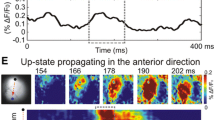Conclusions
-
1.
Investigation of unit activity in the subiculum showed grouping of activity into bursts in 58% of its neurons. Analysis of these neurons revealed two fundamentally different groups: 13% give bursts with long interspike intervals and with a frequency of 4.5–6.0 Hz (“theta”), 45% give dense bursts with a frequency of 2.0–3.8 Hz (“delta”).
-
2.
Of the total number of subicular cells that respond to sensory stimuli, half are multimodal. Tonic responses predominate (51%), phasic (30%) and specific (19%) responses are observed in a minority of cells. The responses are characterized by rapid extinction on repetition of the stimulus, usually with a short initial incremental phase.
-
3.
Abolition of septal afferents leads to complete disappearance of the bursting theta activity, whereas the low-frequency rhythmic bursts are preserved. The number of neurons with tonic responses is reduced in this case and the habituation process is disturbed.
-
4.
Comparative analysis revealed considerable similarity between hippocampal area CA1 and the subiculum with respect to most characteristics of responses of their neurons. This confirms the view that afferent connections from area CA1 make an important contribution to the work of the subiculum and that these structures exhibit morphological and functional unity within the system of the archicortex.
Similar content being viewed by others
Literature cited
V. S. Belokrinitskii, in: Problems in the Physiology of the Hypothalamus [in Russian], No. 7, Kiev (1973), p. 64.
E. S. Brazhnik and O. S. Vinogradova, Zh. Vyssh. Nerv. Deyat.,24, No. 6, 1280 (1974).
E. S. Brazhnik and O. S. Vinogradova, Zh. Vyssh. Nerv. Deyat.,25, No. 5, 1044 (1975).
E. S. Brazhnik and O. S. Vinogradova, Zh. Vyssh. Nerv. Deyat.,28., No. 2, 372 (1978).
O. S. Vinogradova and K. I. Dudaeva, Zh. Vyssh. Nerv. Deyat.,21, No. 3, 577 (1971).
N. A. Kryuchkova, Zh. Vyssh. Nerv. Deyat.,27, No. 2, 297 (1977).
T. S. Sotnichenko, Zh. Évol. Biokhim. Fiziol.,6, No. 6, 571 (1970).
V. S. Stafekhina and O. S. Vinogradova, in: The Limbic System of the Brain [in Russian], Pushchino-on-Oka (1973), p. 191.
V. S. Stafekhina and O. S. Vinogradova, Zh. Vyssh. Nerv. Deyat.,26, No. 5, 1074 (1976).
I. N. Filimonov, Comparative Anatomy of the Mammalian Cerebral Cortex. The Paleocortex, Archicortex, and Intermediate Cortex [in Russian], Moscow (1949).
P. Andersen, B. H. Bland, and J. D. Dudar, Exp. Brain Res.,17, No. 2, 152 (1973).
R. M. Beckstead, Anat. Rec.,187, No. 4, 534 (1977).
T. W. J. Blackstad, J. Comp. Neurol.,105, No. 3, 417 (1956).
S. Ramon-y-Cajal, Studies on the Cerebral Cortex (Limbic Structures), Lloyd-Luke, London (1955).
R. B. Chronister, S. F. Zornetzer, J. J. Bernstein, and L. E. White, Brain Res.,65, No. 1, 13 (1974).
R. B. Chronister, R. W. Sikes, and L. E. White, in: The-Septal Nuclei, (J. F. de France, ed., Plenum Press, New York (1976), p. 115.
V. B. Domesick, Brain Res.,12, No. 1, 296 (1969).
S. E. Fox and J. B. Ranck, Exp. Neurol.,49, No. 2, 299 (1975).
A. J. Hjorth-Simonsen, J. Comp. Neurol.,147, No. 1, 145 (1973).
R. C. Meibach and A. Siegel, Brain Res.,88, No. 3, 508 (1975).
R. C. Meibach and A. Siegel, Brain Res.,124, No. 2, 197 (1977).
J. B. Ranck, in: The Hippocampus, (R. L. Isaacson and K. H. Pribram, eds.), Vol. 2, Plenum Press, New York (1975), p. 207.
D. N. Pandya, V. B. Domesick, G. W. von Hoesen, and M. M. Mesulam, Anat. Rec.,172, No. 2, 379a (1972).
D. L. Rosene, G. W. von Hoesen, and M. M. Mesulam, Anat. Rec.,184, No. 3, 517 (1976).
L. W. Swanson and W. M. Cowan, J. Comp. Neurol.,172, No. 1, 49 (1977).
Author information
Authors and Affiliations
Additional information
Translated from Zhurnal Vysshei Nervnoi Deyatel'nosti, Vol. 29, No. 5, pp. 1009–1017, September–October, 1979.
Rights and permissions
About this article
Cite this article
Stafekhina, V.S., Vinogradova, O.S. Characteristics of unit activity in hippocampal structures (the subiculum). Neurosci Behav Physiol 11, 587–594 (1981). https://doi.org/10.1007/BF01186838
Received:
Issue Date:
DOI: https://doi.org/10.1007/BF01186838




